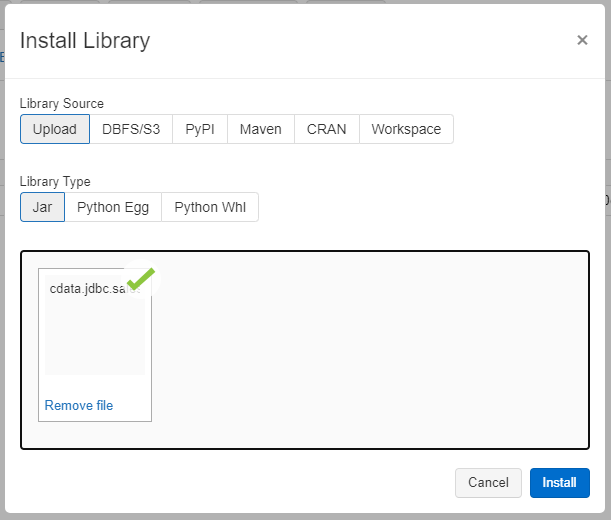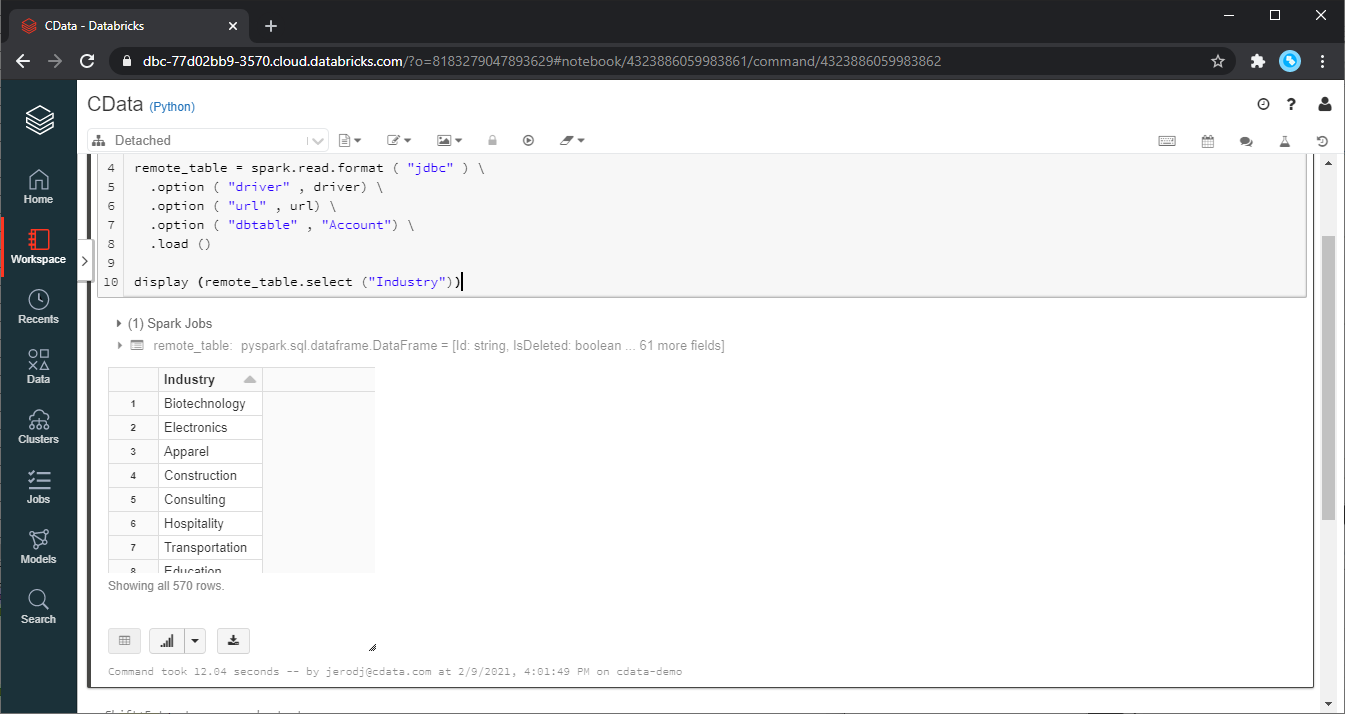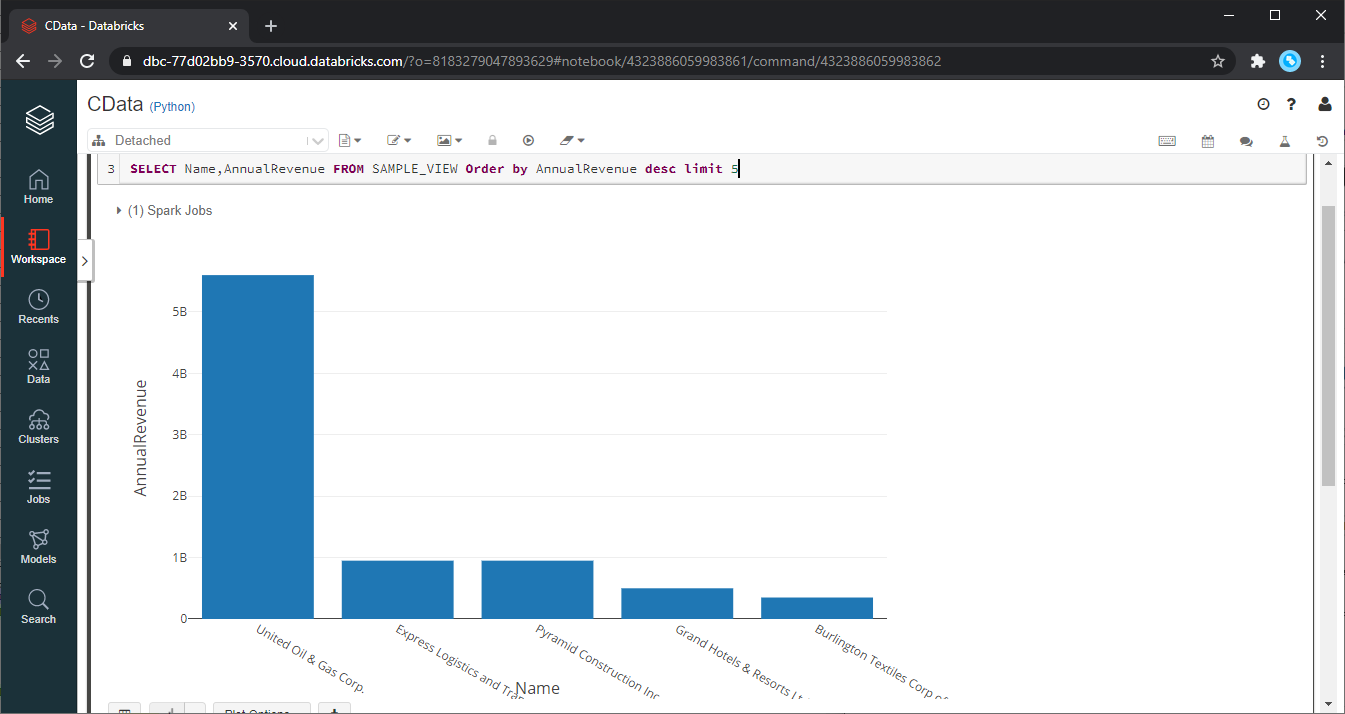Model Context Protocol (MCP) finally gives AI models a way to access the business data needed to make them really useful at work. CData MCP Servers have the depth and performance to make sure AI has access to all of the answers.
Try them now for free →Process & Analyze Google Spanner Data in Databricks (AWS)
Use CData, AWS, and Databricks to perform data engineering and data science on live Google Spanner Data.
Databricks is a cloud-based service that provides data processing capabilities through Apache Spark. When paired with the CData JDBC Driver, customers can use Databricks to perform data engineering and data science on live Google Spanner data. This article walks through hosting the CData JDBC Driver in AWS, as well as connecting to and processing live Google Spanner data in Databricks.
With built-in optimized data processing, the CData JDBC Driver offers unmatched performance for interacting with live Google Spanner data. When you issue complex SQL queries to Google Spanner, the driver pushes supported SQL operations, like filters and aggregations, directly to Google Spanner and utilizes the embedded SQL engine to process unsupported operations client-side (often SQL functions and JOIN operations). Its built-in dynamic metadata querying allows you to work with and analyze Google Spanner data using native data types.
Install the CData JDBC Driver in Databricks
To work with live Google Spanner data in Databricks, install the driver on your Databricks cluster.
- Navigate to your Databricks administration screen and select the target cluster.
- On the Libraries tab, click "Install New."
- Select "Upload" as the Library Source and "Jar" as the Library Type.
- Upload the JDBC JAR file (cdata.jdbc.googlespanner.jar) from the installation location (typically C:\Program Files\CData[product_name]\lib).

Access Google Spanner Data in your Notebook: Python
With the JAR file installed, we are ready to work with live Google Spanner data in Databricks. Start by creating a new notebook in your workspace. Name the notebook, select Python as the language (though Scala is available as well), and choose the cluster where you installed the JDBC driver. When the notebook launches, we can configure the connection, query Google Spanner, and create a basic report.
Configure the Connection to Google Spanner
Connect to Google Spanner by referencing the JDBC Driver class and constructing a connection string to use in the JDBC URL. Additionally, you will need to set the RTK property in the JDBC URL (unless you are using a Beta driver). You can view the licensing file included in the installation for information on how to set this property.
Step 1: Connection Information
driver = "cdata.jdbc.googlespanner.GoogleSpannerDriver" url = "jdbc:googlespanner:RTK=5246...;ProjectId='project1';InstanceId='instance1';Database='db1';InitiateOAuth=GETANDREFRESH"
Built-in Connection String Designer
For assistance in constructing the JDBC URL, use the connection string designer built into the Google Spanner JDBC Driver. Either double-click the JAR file or execute the jar file from the command-line.
java -jar cdata.jdbc.googlespanner.jar
Fill in the connection properties and copy the connection string to the clipboard.
Google Spanner uses the OAuth authentication standard. To authenticate using OAuth, you can use the embedded credentials or register an app with Google.
See the Getting Started guide in the CData driver documentation for more information.

Load Google Spanner Data
Once you configure the connection, you can load Google Spanner data as a dataframe using the CData JDBC Driver and the connection information.
Step 2: Reading the data
remote_table = spark.read.format ( "jdbc" ) \ .option ( "driver" , driver) \ .option ( "url" , url) \ .option ( "dbtable" , "Customer") \ .load ()
Display Google Spanner Data
Check the loaded Google Spanner data by calling the display function.
Step 3: Checking the result
display (remote_table.select ("Name"))

Analyze Google Spanner Data in Databricks
If you want to process data with Databricks SparkSQL, register the loaded data as a Temp View.
Step 4: Create a view or table
remote_table.createOrReplaceTempView ( "SAMPLE_VIEW" )
With the Temp View created, you can use SparkSQL to retrieve the Google Spanner data for reporting, visualization, and analysis.
% sql SELECT Name, TotalDue FROM SAMPLE_VIEW ORDER BY TotalDue DESC LIMIT 5

The data from Google Spanner is only available in the target notebook. If you want to use it with other users, save it as a table.
remote_table.write.format ( "parquet" ) .saveAsTable ( "SAMPLE_TABLE" )
Download a free, 30-day trial of the CData JDBC Driver for Google Spanner and start working with your live Google Spanner data in Databricks. Reach out to our Support Team if you have any questions.

